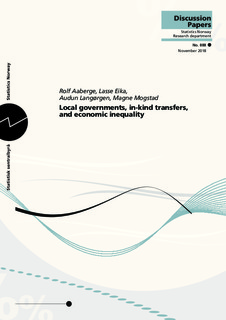| dc.contributor.author | Aaberge, Rolf | |
| dc.contributor.author | Eika, Lasse | |
| dc.contributor.author | Langørgen, Audun | |
| dc.contributor.author | Mogstad, Magne | |
| dc.coverage.spatial | Norway | nb_NO |
| dc.date.accessioned | 2019-11-08T14:39:07Z | |
| dc.date.available | 2019-11-08T14:39:07Z | |
| dc.date.issued | 2018-11 | |
| dc.identifier.issn | 1892-753X | |
| dc.identifier.uri | http://hdl.handle.net/11250/2627476 | |
| dc.description.abstract | We examine how in-kind transfers provided by local governments affect economic inequality. The allocation of in-kind transfers to households and the adjustment for differences in needs are derived from a model of local government spending behavior. The model distinguishes between fixed and variable costs in production as well as mandatory programmatic spending components versus discretionary spending on different service sectors and target groups. To estimate the model, we combine Norwegian data from municipal accounts and administrative registers for the period 1982-2013. We find that economic inequality is considerably lower when taking in-kind transfers into account. While the poor benefit from receiving a relatively large share of public services, the equalizing effect of in-kind transfers tends to be smaller than the equalizing contribution from public cash transfers. When examining the time trends in inequality, we find that local governments attenuated the growth in cash income inequality by re-allocating in-kind transfers to low-income families. This reduction in inequality is mostly due to changes in spending priorities across service sectors and target groups, whilst the contribution from re-allocation of resources across municipalities is much smaller. | nb_NO |
| dc.description.abstract | Vi undersøker hvordan fordelingen av individrettete kommunale tjenester påvirker økonomisk ulikhet. Verdsettingen, behovsjusteringen og allokeringen av kommunale tjenester til hushold er basert på en modell for kommunenes økonomiske atferd. Modellen allokerer bundne kostnader og frie disponible inntekter til ulike tjenesteytende sektorer og målgrupper, og den skiller mellom faste og variable kostnader i produksjonen. For å estimere modellen kombinerer vi data fra kommunale regnskaper og administrative registre for perioden 1982-2013. Vi finner at økonomisk ulikhet er betydelig lavere når vi tar hensyn til verdien av mottatte kommunale tjenester. Selv om de fattige mottar en relativt stor andel av de kommunale tjenestene, viser analysen at de kommunale tjenestene virker mindre utjevnende enn offentlige kontantoverføringer. Når vi undersøker utviklingen i ulikhet over tid, finner vi at kommunene har bidratt til å dempe økningen i inntektsulikhet gjennom reallokering av tjenester til lavinntektsfamilier. Denne reduksjonen i ulikhet skyldes for det meste endringer i prioriteringene mellom tjenestesektorer og målgrupper, og i mindre grad omfordeling av ressurser mellom kommunene | nb_NO |
| dc.language.iso | eng | nb_NO |
| dc.publisher | Statistisk sentralbyrå | nb_NO |
| dc.relation.ispartofseries | Discussion papers;888 | |
| dc.subject | JEL classification: D31 | nb_NO |
| dc.subject | JEL classification: H72 | nb_NO |
| dc.subject | JEL classification: I30 | nb_NO |
| dc.title | Local governments, in-kind transfers, and economic inequality | nb_NO |
| dc.type | Working paper | nb_NO |
| dc.description.version | publishedVersion | nb_NO |
| dc.subject.nsi | VDP::Matematikk og Naturvitenskap: 400::Matematikk: 410::Statistikk: 412 | nb_NO |
| dc.source.pagenumber | 45 | nb_NO |
